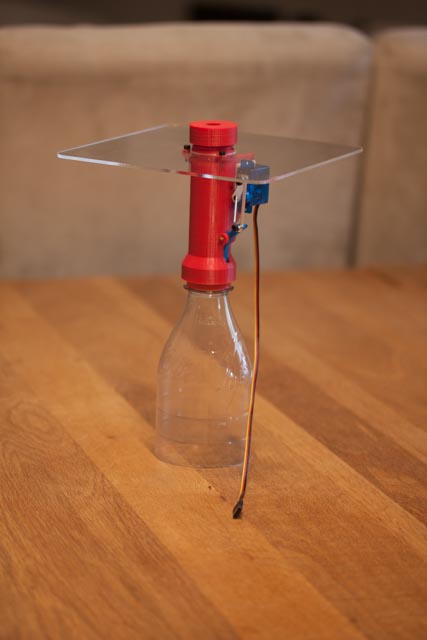 This week, we decided to write a more entertaining post. It's an experiment to be done with children: adding a few Mentos candies into a Coke bottle to literally create a Coke geyser. The difficulty in this experiment is that the reaction happens so fast that one often finds oneself drenched with Coke. We decided to create a device allowing us to trigger this reaction from afar.
This week, we decided to write a more entertaining post. It's an experiment to be done with children: adding a few Mentos candies into a Coke bottle to literally create a Coke geyser. The difficulty in this experiment is that the reaction happens so fast that one often finds oneself drenched with Coke. We decided to create a device allowing us to trigger this reaction from afar.
We are not going to explain the details of the reaction between Coke and Mentos candies, others do it much better than we do. What you must remember is that adding Mentos candies into a soda bottle triggers a brutal separation of the CO2 contained in the drink. This reaction is so rapid that it causes the expulsion of most of the bottle content. The phenomenon occurs with any soda but only with mint-flavored Mentos candies. It seems that 6 Mentos for 2 liters of Diet Coke is the most spectacular mix.

Here is the result of 6 Mentos into 2 liters of Diet Coke
To insert 6 Mentos in a Diet Coke bottle and to go away flee before you are spayed is more difficult that it appears. We have therefore decided to build a remote-controlled trigger.

An expended view of our trigger
We designed a tube that you can screw on a Coke bottle instead of its cap. A small lever maintains the Mentos in the tube while you go away. This lever is linked to a servomotor driven by a Yocto-Servo connected to a YoctoHub-Wireless-g. When you are far enough, you can control the servomotor from a smartphone and free the tube so that the Mentos fall into the bottle.

The top of this tube is threaded, allowing you to test several nozzle sizes
It's relatively easy to make this device if you have access to a 3D printer. The servomotor is fixed with double-sided tape, and the lever pivot is a simple toothpick. The Plexiglass protection window can be replaced by a wood or printed plate. The 3D model is available on Thingverse.

Our trigger retains the Mentos to give us time to go away from the experiment...
To remotely control the servomotor, we wrote a short Android application, which connects itself to the YoctoHub-Wireless-g and changes the position of the Yocto-Servo. The application is very simple and looks like the application that we used in this previous post.

The smartphone controls the Yocto-Servo using the Wifi network
We used an Android application for practical reasons, but you can also write a web application hosted directly on the YoctoHub-Wireless-g as we did it in this other post.
The application source code and the compiled application are available on GItHub: http://github.com/yoctopuce-examples/yocto-mentos.
Here are a video that we took while using this trigger:
Well, now you just need to go shopping and warm up the 3D printer :-)


